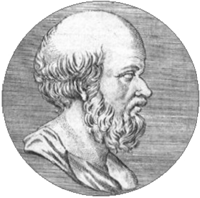- 1610: Galileo
- 1676: Ole Rømer
- 1687: Isaac Newton
- 1781: William Herschel
- 1838: Friedrich Bessel
- 1861: William and Margaret Huggins
- 1912: Henrietta Leavitt
- 1917 Einstein
- 1920: Harlow Shapley
- 1929 Edwin Hubble
- 1948: Ralph Alpher
- 1949: Fred Hoyle
- 1963: Maarten Schmidt
- 1964: Arno Penzias and Robert Wilson
- 1978: Vera Rubin and Kent Ford
- 1989: Margaret Geller and John Huchra
- 1992: John Mather and George Smoot
- 1995: Robert Williams
- 1998: Saul Perlmutter and Brian Schmidt
- 2010: Wendy Freedman
Eratosthenes
 Eratosthenes was the third librarian in the Great Library of Alexandria, Egypt, around 240 BC. Among his many accomplishments was the determination of Earth’s circumference. While there is some debate about the units he used, so far as historians are able to tell, his result was remarkably similar to the value known today.
Eratosthenes was the third librarian in the Great Library of Alexandria, Egypt, around 240 BC. Among his many accomplishments was the determination of Earth’s circumference. While there is some debate about the units he used, so far as historians are able to tell, his result was remarkably similar to the value known today.
Eratosthenes’ method was based on the fact that a stick placed vertically in the ground in his hometown of Alexandria would make a shadow on the longest day of summer. On that same day a vertical stick in Syene (modern Aswam) would form no shadow at all.
Eratosthenes arranged for someone to count their paces as they walked from Alexandria to Syene, and found the distance to be 5000 stadia (about 500 miles).
 He also measured the angle formed by the shadow of the vertical stick in Alexandria, which he found to be 1/50th of a circle. He concluded that Alexandria was one fiftieth of the way around the Earth from Syene. So he multiplied the distance between Alexandria and Syene by 50 to get the Earth’s circumference.
He also measured the angle formed by the shadow of the vertical stick in Alexandria, which he found to be 1/50th of a circle. He concluded that Alexandria was one fiftieth of the way around the Earth from Syene. So he multiplied the distance between Alexandria and Syene by 50 to get the Earth’s circumference.